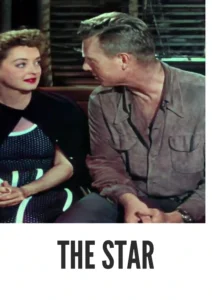Video Sources 0 Views

Synopsis

Delve into the tumultuous world of Hollywood with The Star, a poignant melodrama from 1952, now beautifully colorized to intensify its emotional depth. Starring the incomparable Bette Davis, this film explores the trials and tribulations of an aging actress grappling with fading fame and a desperate need to reclaim her former glory. Perfect for fans of classic Hollywood dramas and those captivated by stories of ambition, heartbreak, and resilience, this HD download offers a compelling glimpse into the darker side of the entertainment industry. This film was also released as I Hate Women.
The Star tells the story of Margaret Elliot (Bette Davis), a former Oscar-winning actress whose career has taken a sharp decline. Once adored by millions, Margaret now struggles to find work and maintain her lavish lifestyle, clinging to memories of her past success.
As Margaret’s financial situation becomes increasingly dire, she faces the harsh reality of her fading relevance in Hollywood. Her pride and stubbornness hinder her ability to accept help from others, including her former co-star and loyal friend, Jim Johannson (Sterling Hayden), who still harbors feelings for her. Desperate to revive her career, Margaret makes a series of questionable decisions that further alienate her from those around her. The film culminates in a dramatic confrontation that forces Margaret to confront her own flaws and make a difficult choice about her future. Ultimately, The Star is a powerful and moving story about the price of fame and the challenges of reinvention.
The film features a stellar cast of actors who bring this emotional story to life:
-
Bette Davis as Margaret Elliot
-
Sterling Hayden as Jim Johannson
-
Natalie Wood as Gretchen
-
Warner Anderson as Joe Morrison
-
Joan Leslie as Toni Nichols
The Star firmly resides in the melodrama genre, characterized by its heightened emotions, dramatic conflicts, and focus on the inner lives of its characters. The film also incorporates elements of social commentary, offering a critical look at the superficiality and cutthroat nature of Hollywood.
Released in 1952, The Star reflects the changing landscape of Hollywood in the post-World War II era. The film addresses themes of aging, obsolescence, and the challenges faced by women in a male-dominated industry. Bette Davis’s powerful performance as Margaret Elliot challenged traditional portrayals of female characters, offering a complex and nuanced portrayal of a woman struggling against societal expectations and personal demons. The Star is a poignant commentary on the fleeting nature of fame and the importance of self-acceptance.
This colorized version of The Star has been meticulously restored using state-of-the-art digital techniques, enhancing the visual impact while preserving the film’s original emotional intensity. The colorization process involved carefully analyzing the grayscale tones of the original black and white footage and assigning appropriate colors to each scene, paying close attention to details such as costume design, set decoration, and skin tones. The techniques employed included advanced algorithms for color palette selection, image enhancement, and color correction. This painstaking process breathes new life into the characters and settings, making the story even more captivating for contemporary audiences. While the artistic merit of colorizing classic films remains a subject of debate, it serves as a valuable tool for introducing these cinematic treasures to a wider audience, ensuring their enduring legacy for generations to come.
-
: Stuart Heisler
-
: Dale Eunson, Katherine Albert
-
: Dale Eunson, Katherine Albert
-
: Ernest Laszlo
-
: Christian Nyby
-
: Bert E. Friedlob Productions
-
: 20th Century Fox
-
: 89 minutes
-
: MP4
-
: HD (1080p)
-
: Compatible with most devices, including smartphones, tablets, computers, and smart TVs.
The Star (1952) received mixed reviews upon its initial release, but Bette Davis’s performance was universally praised. The film has since been recognized as a significant work in Davis’s filmography, showcasing her ability to portray complex and flawed characters with depth and vulnerability. The film garnered an Academy Award nomination for Best Costume Design. The Star remains a compelling and thought-provoking exploration of the dark side of Hollywood and the challenges faced by women in the entertainment industry.
-
: What is The Star about?
-
A: The Star is a melodrama about a former Hollywood actress struggling to cope with her fading fame and declining career.
-
-
: Is The Star (1952) considered a classic Bette Davis film?
-
A: Yes, The Star is recognized as a significant work in Bette Davis’s filmography, showcasing her powerful acting skills.
-
-
: Is this version of The Star colorized?
-
A: Yes, this version has been professionally colorized to enhance the viewing experience.
-
-
: What themes does The Star explore?
-
A: The Star explores themes of aging, obsolescence, the price of fame, and the challenges faced by women in Hollywood.
-
-
: What is the download format?
-
A: The download format is MP4, which is compatible with most devices.
-
-
: What resolution is the download?
-
A: The resolution is HD (1080p), providing a high-quality viewing experience.
-
Experience The Star Today!










